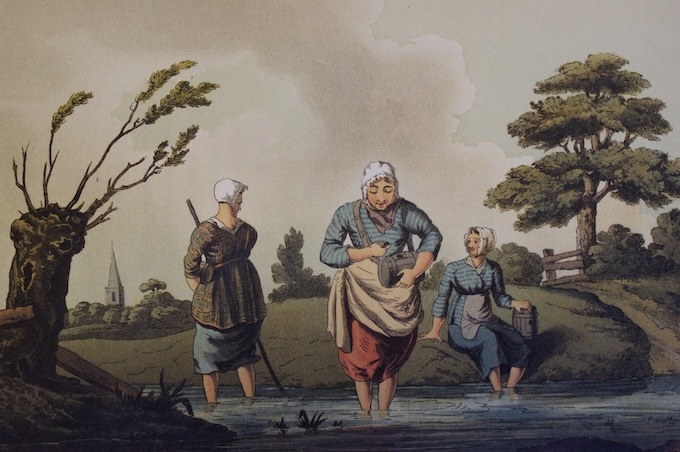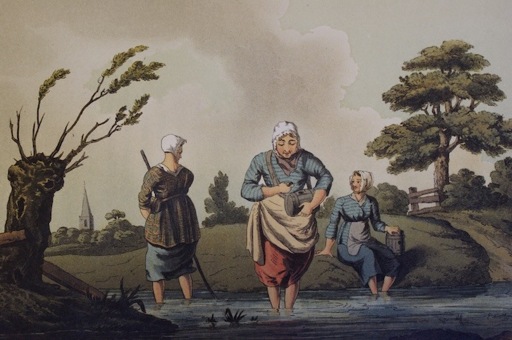

Leech finders, The Costume of Yorkshire, George Walker (1814) CREDIT: Science Museum Group ©.
Common people used to be people of the commons. Leah Gordon & Stephen Ellcock with additional writing by Annabel Edwards, Common People: A Folk History of Land Rights, Enclosure and Resistance (Watkins: London 2025) explain this in such a lovely book. It brings together word and picture. Of the 240 pages there is scarcely an image-less page and no image without good speech quoted along with. I will say something about each but first overall on this the 500th anniversary of the German Peasants’ Revolt the book is introduced by images of Albrecht Dürer’s “Monument to the Vanquished Peasants.”
At the foundation of the column are sheep, pigs, and cattle then arising from the base a basket of eggs and another of bread, followed by implements of cultivation – the flail, the pitchfork, and spade, then a sheaf of grain, a butter churn, a chicken coop, and finally the dejected figure of the seated peasant with his head in his hands, and a knife in his back. The earthly plenty, the peaceable kingdom, good food, and the symbols of happy life have been ruined to near extinction by the class war. Likewise, these are the two moral poles in every word and every image, namely, human collective creativity with and in the land and abiding clear-sighted anger against the powers that hoard it to themselves. The two feelings are held in balance succumbing neither to amnesia nor to nostalgia.
After this introduction we plunge right in to history and its dates, eight pages of clear timeline of enclosures and resistance. Here are the facts of the English class war between the Haves and the Have Nots. These facts form what E.P. Thompson would call “idioms” or “peculiarities of the English.” I looked up the word “idiom” in Fowler’s Dictionary of Modern English Usage and learned that it comes from a Greek word closely translated as “a manifestation of the peculiar” and Fowler explained that in the realm of speech this might refer to what is peculiar to the language of a people, the dialect of a district, or the vocabulary of a technique. The idiomatic exists alongside, though not against, abstract grammar. So it is with commoners and their powers of pasturage, estovers, turbary, pannage, piscary: all are idiomatic, that is, peculiar to language, district, and profession. Some might mistake the idiomatic with the incidental or trivial.
Look at the pictures of Crow Scaring, another of Twig Gathering, or Gleaners, or Leech Finders, or Acorn Knockers. We are invited to remember the world where Adam delved and Eve span. It is through them that we begin to find uncanny, magical, and spiritual relations.
Poacher (2025) CREDIT: Leah Gordon (A Meadow Arts Commission).
To indicate this graphically a series of eighteen commoners in the county of Shropshire are photographed in their commons with other creatures (horse, cattle, pig, fish, dogs of course) and their favored implements (ribbon, ice-skates, rope, a lawn-mower, an axe). The people are centered in the middle, they are surrounded by earth, water, trees, and grass. Far from trivial or anecdotal, these photographs have been hand-tinted by Marg Duston in delicate, lightly saturated but unmistakable hues. The impression is beautiful, lending to the commoners their own down-to-earth sovereignty – peculiar, idiomatic, and majestic.
Annabel Edwards addresses us directly (in the second person) to provide the narrative of the English enclosures. She places them in a planetary context with the American prairies, the South American pampas, the Australian outback, and the African savannah, and we begin to see the English peasantry with indigenous folks of the world. In June 1381 John Ball said,
“My good friends, matters cannot go on well in England until all things shall be in common; when there shall be neither vassals nor lords; when the lords shall be no more masters than ourselves.”
It was the beginning of that peculiar, idiomatic expression of English indigenous eloquence of freedom we find in Thomas More, Robert Kett, Gerrard Winstanley, John Clare. “Arise Albion!” was their call against the enclosures of land, and so it will be towards the end of this book. But first….
The chapter on ‘Rural Rebels and Traditions’ begins with ten well-chosen illustrations with an emphasis on disguise, masking, cross-dressing, black face, fools, jesters, and mummers, and then a further two dozen photos and art of the resistance embedded in the deep folk history of opposition – the hobby horse, the straw bear, the sweep, Morris dancer, Jack-in-the-Green, oak apple day, the green man, mari lwyd, hoodening, the burryman. Like the Flora Britannica wonderfully described in Richard Mabey’s book of the same title, these popular forms are particular to place and peculiar to community life in the commons, “the granular minutiae of quotidian peasant activities.”
The Burryman, South Queensferry, West Lothian (2010). CREDIT: Leah Gordon.
Yet these are exactly the gateway to the whole world, as Leah Gordon explains in the ‘Cosmology of the Rural.’ The enclosure of land is accompanied by the abolition and degradation of the art and joys of the past. The authors discover alternative stories in lesser-known artists like Samuel Palmer of John Cotman. Collecting reeds, fishing for eels, or collecting peat help knit a cosmology from below. Three dozen beautiful artworks – paintings, drawings, photos, collages – then follow. These prepare us for consideration of what happened next, what happened after the enclosure, what happened to the wandering souls soon to be shoved into “cottonopolis,” the soulless factories of industrial capitalism.
Yes, the famed English working-class began existence with exactly this wandering, that is as vagabonds. Here they are presented as history both old and new: rural rebels following Captain Swing, the rat catcher, the poacher, the alewife, the itinerant potter, and the campers at the Rainbow Circle in the Forest of Dean living in the tipis of the Great Plains of Turtle Island, not in destitute indigence, but near naked solidarity with the world’s indigenous peoples. “Arise Albion!” cries a concluding chapter with its accounts of the road protests, the demands for the right to roam, the musical raves, the Kinder Scout Mass Trespass (1932), the Battle of the Beanfield at Stonehenge (1985), and the women’s peace camp at Greenham Common (1981).
John Heighway, Clee Liberty Rights: Grazing sheep, cattle and horses (2022) CREDIT: Leah Gordon, Hand-tinting by Marg Duston (A Meadow Arts Commission).
Actually, this book concludes not with the wandering and mobility caused by the colossal loss of the commons, but with a small but deep-rooted concession wrenched from the enclosing jaws of capitalism, that is, with the permanence and habitation allowed by small-scale gardening of allotment cultivation. If you fly into England in day light, you’ll see the hedges of enclosure. Then from the airport out the window of the tube or the train you’ll pass at the edge of town the allotments. They are the restoration of small plots of land to the landless, and the photographs that follow are tender, accurate, depictions of pure harmony between ordinary people and the fruits of the earth in this case around Coventry. Taken together they comprise “positive strategy to reunite people of all races with the commons.”
The post Common People appeared first on CounterPunch.org.
From CounterPunch.org via this RSS feed


